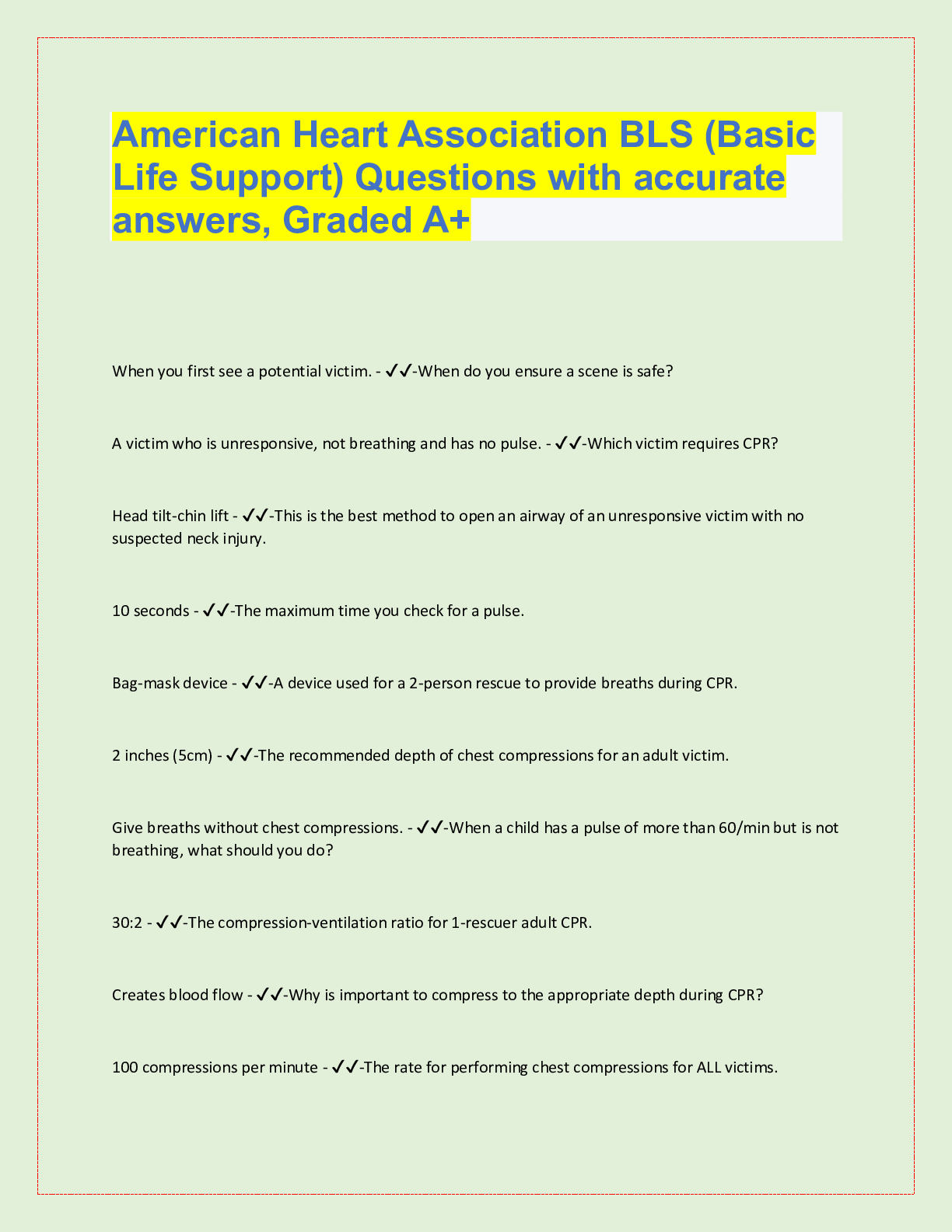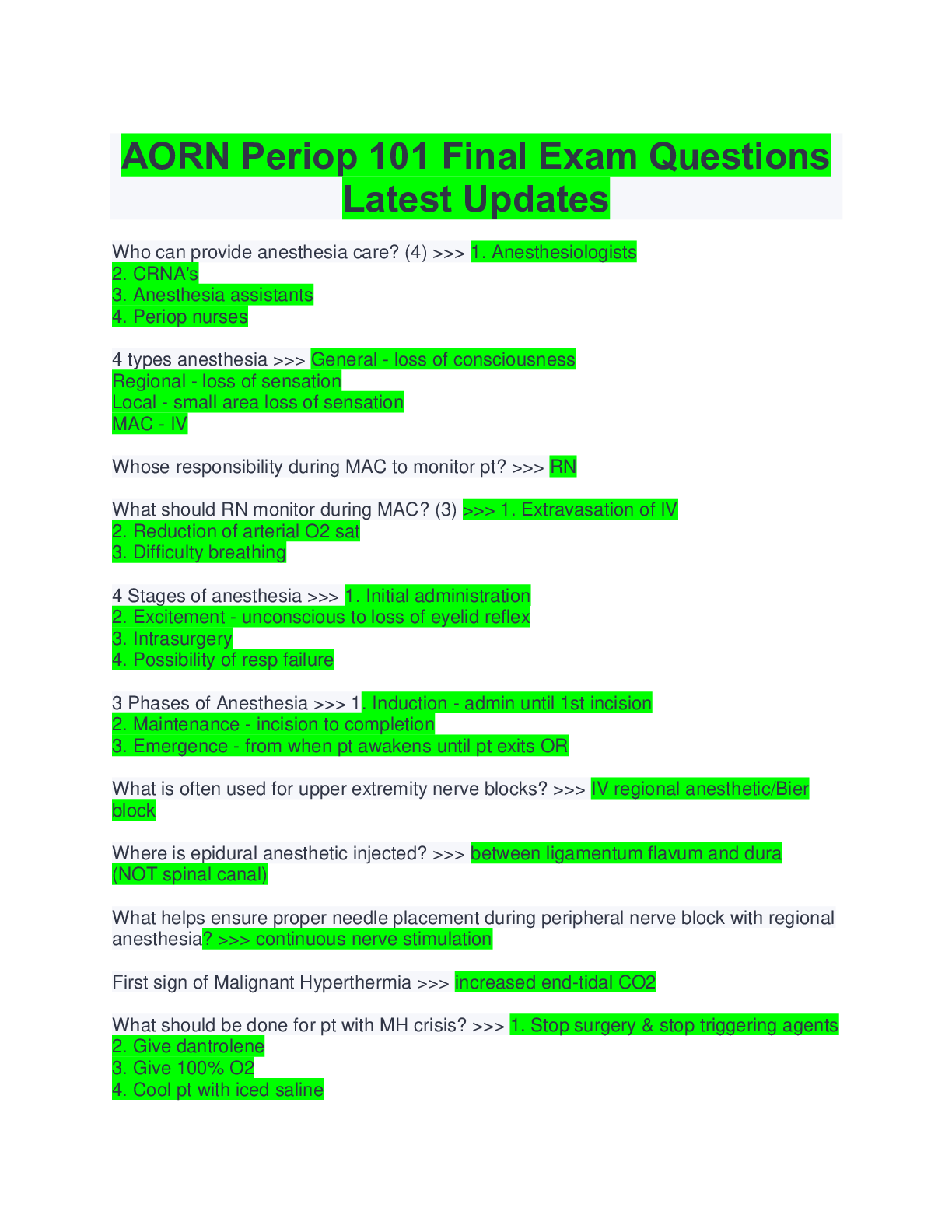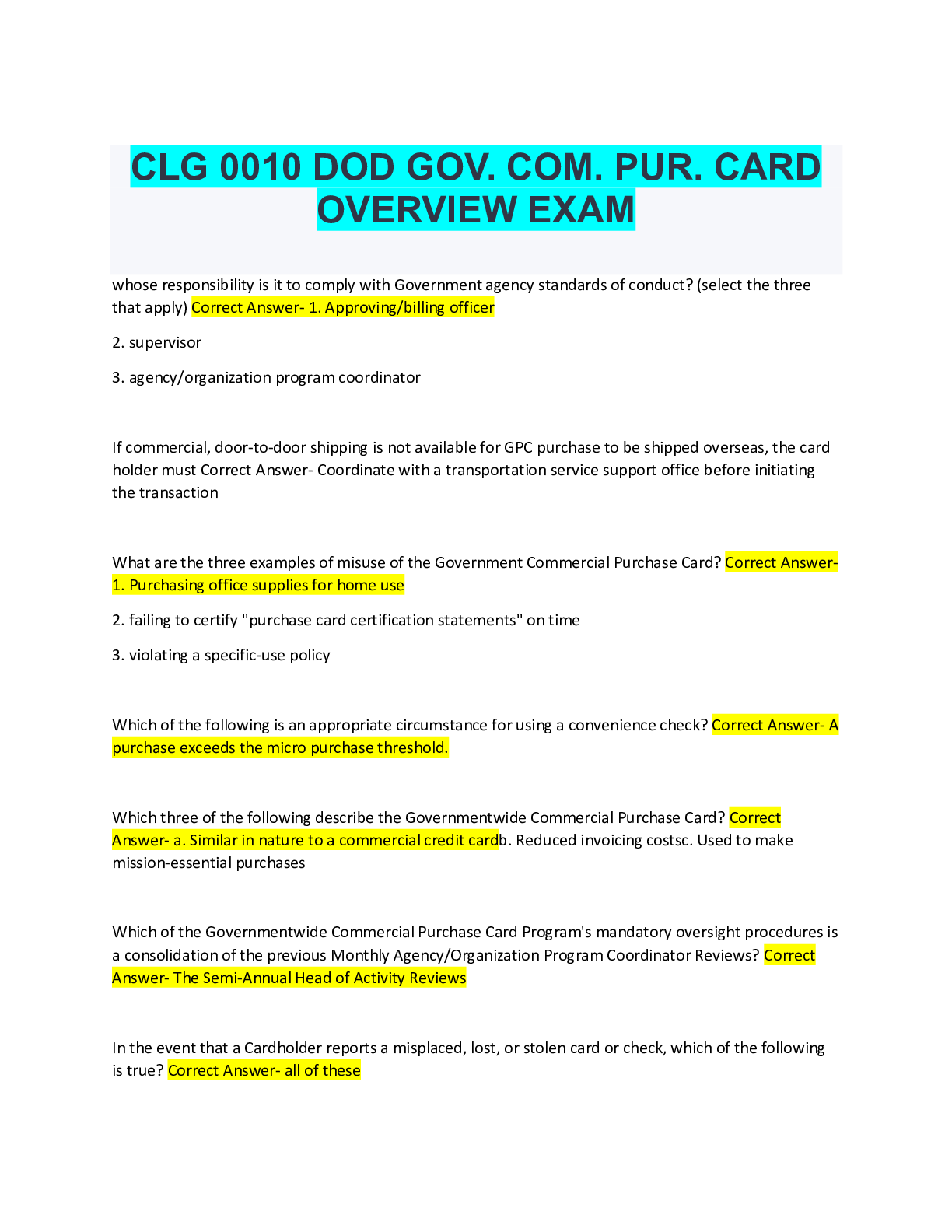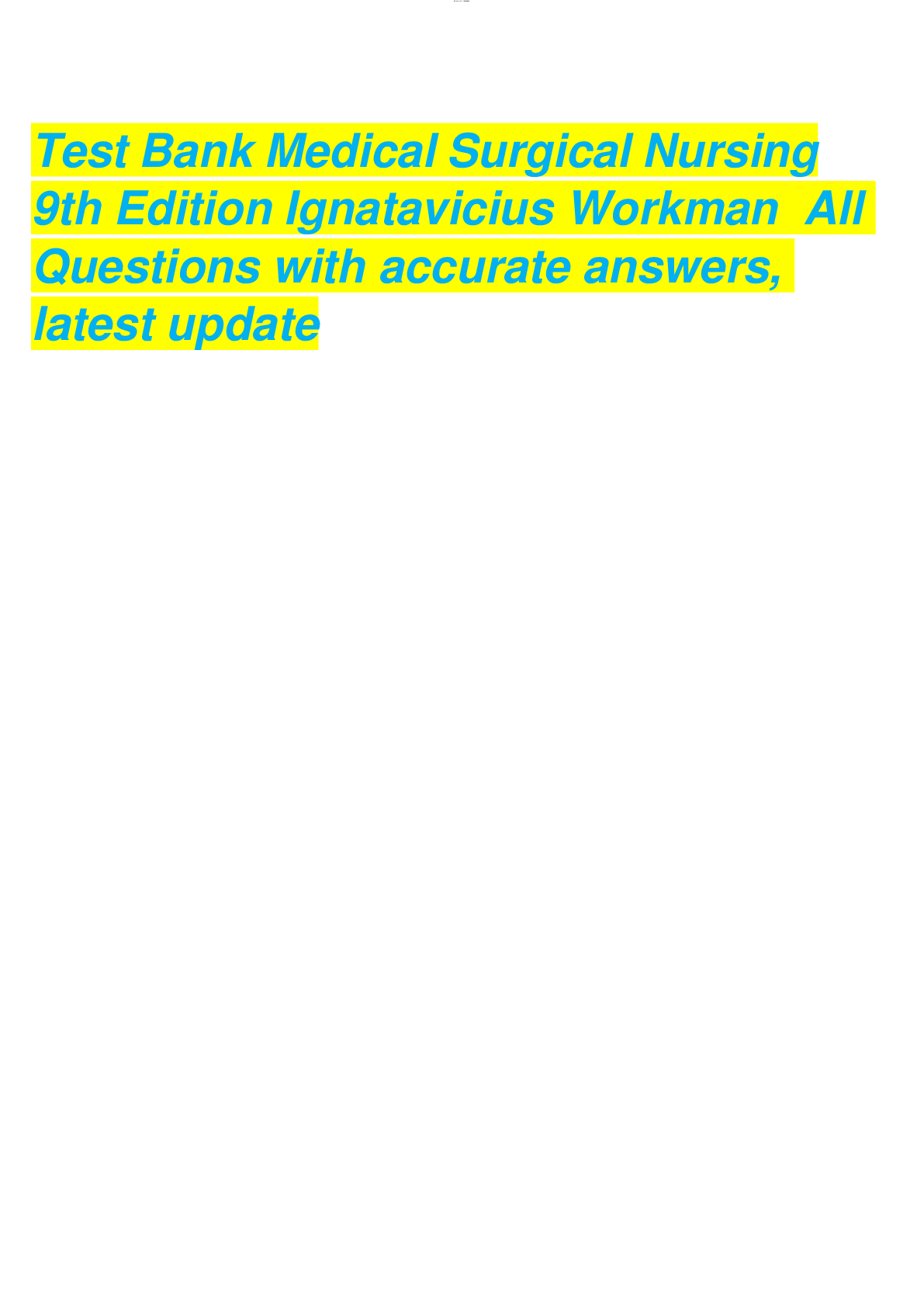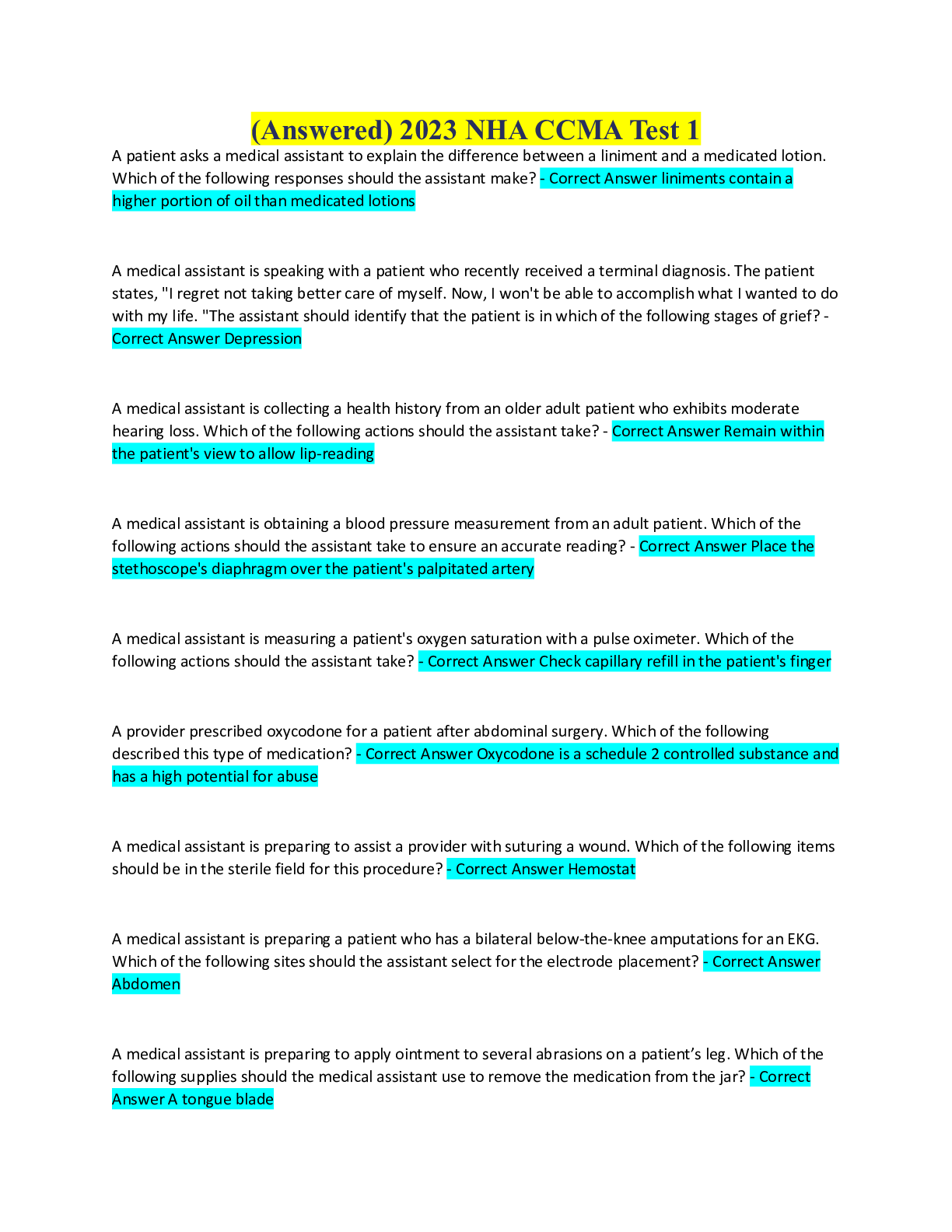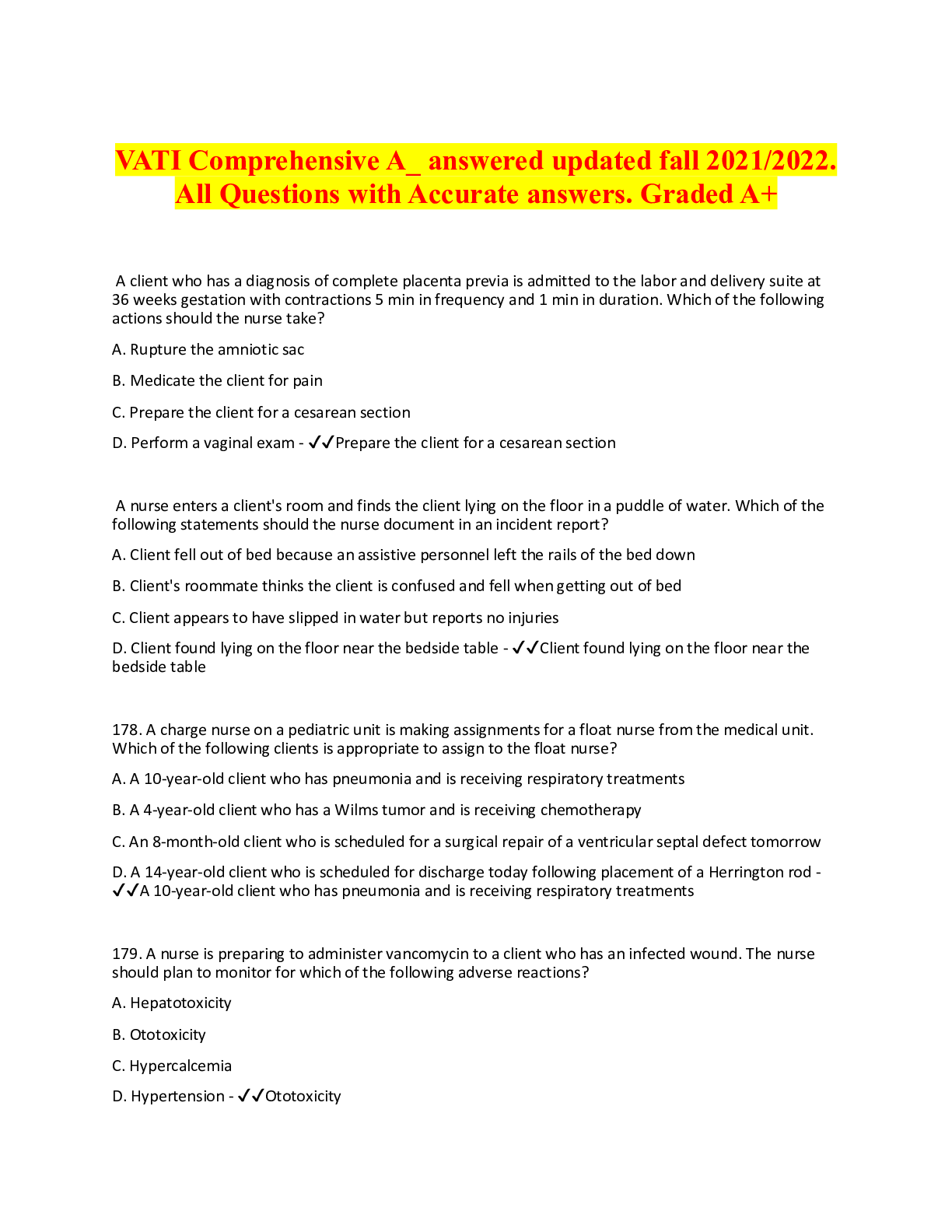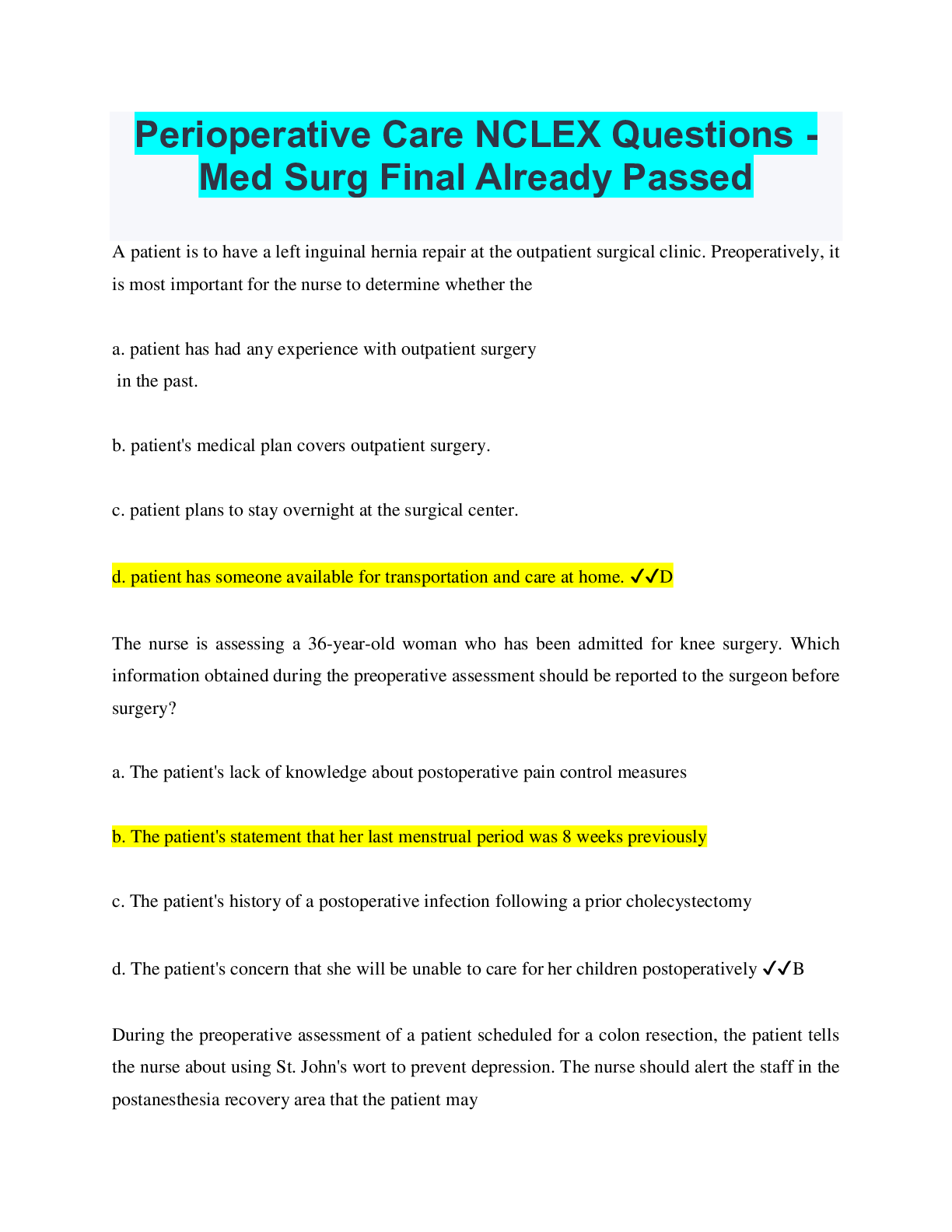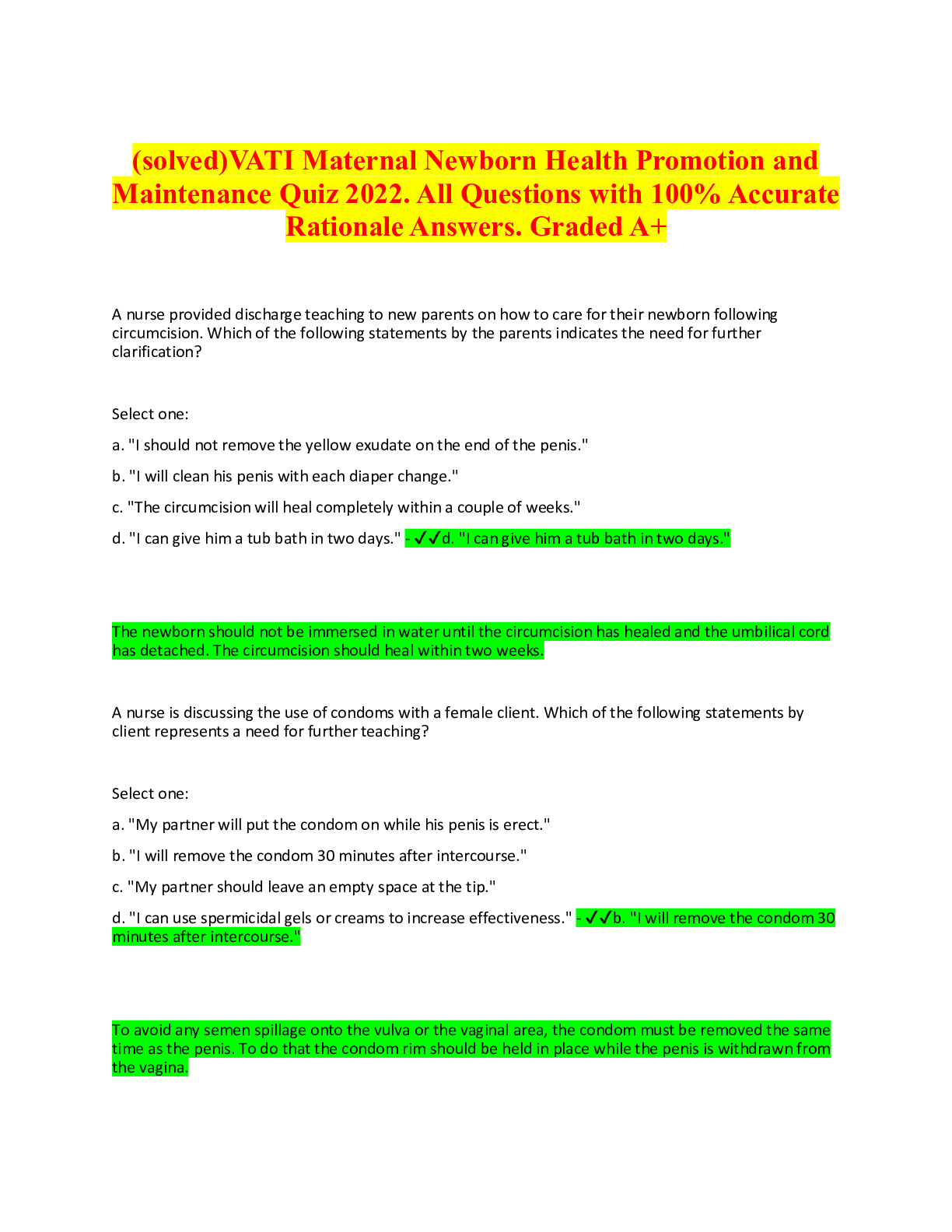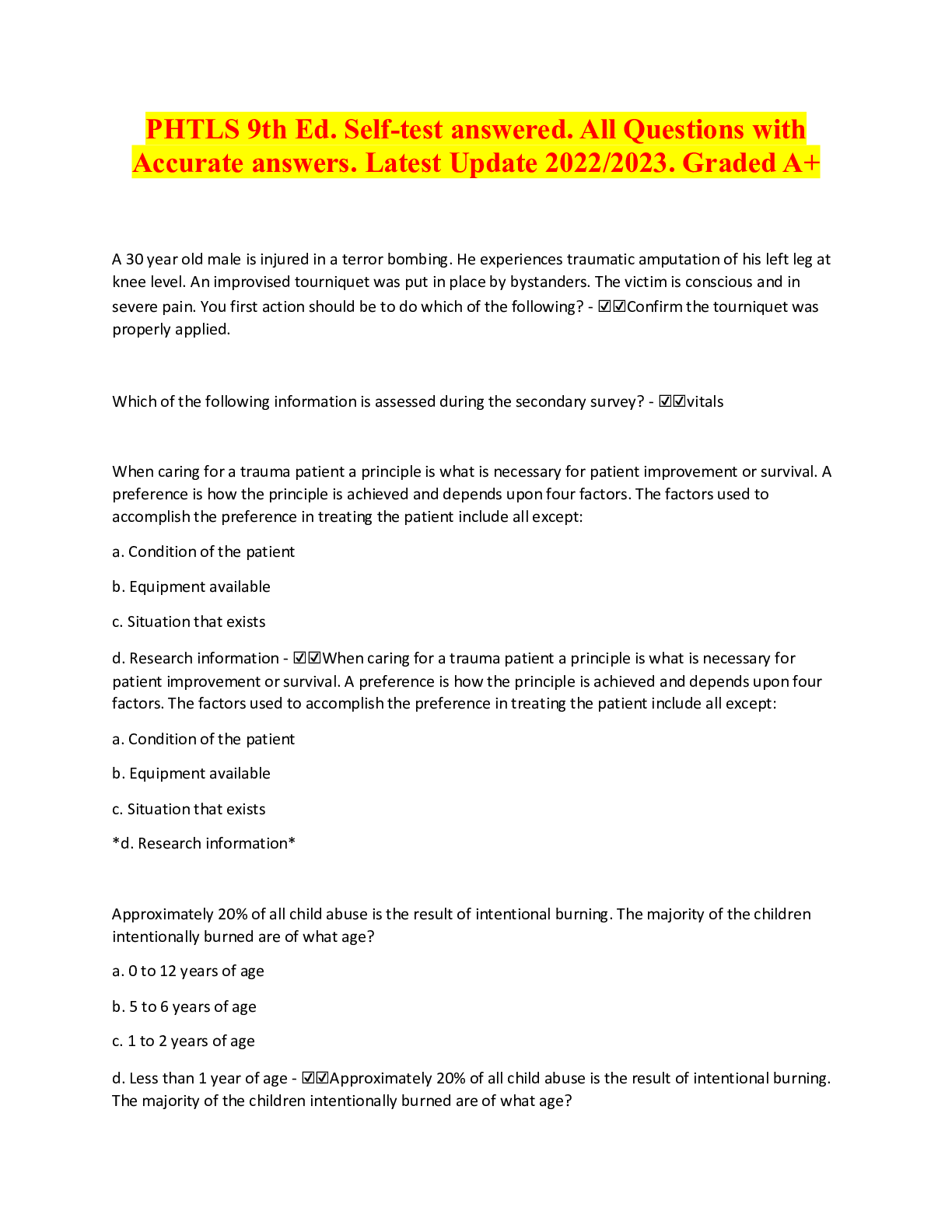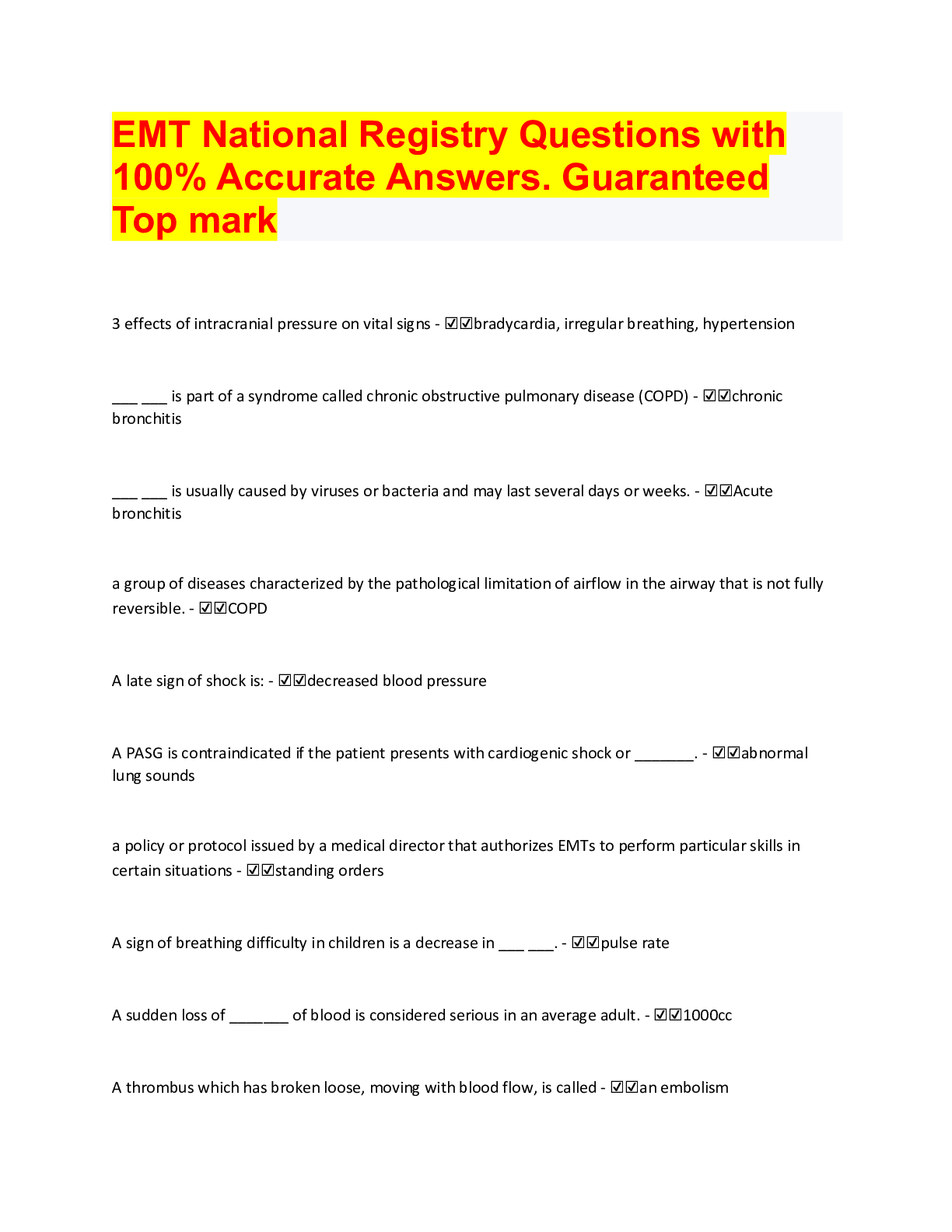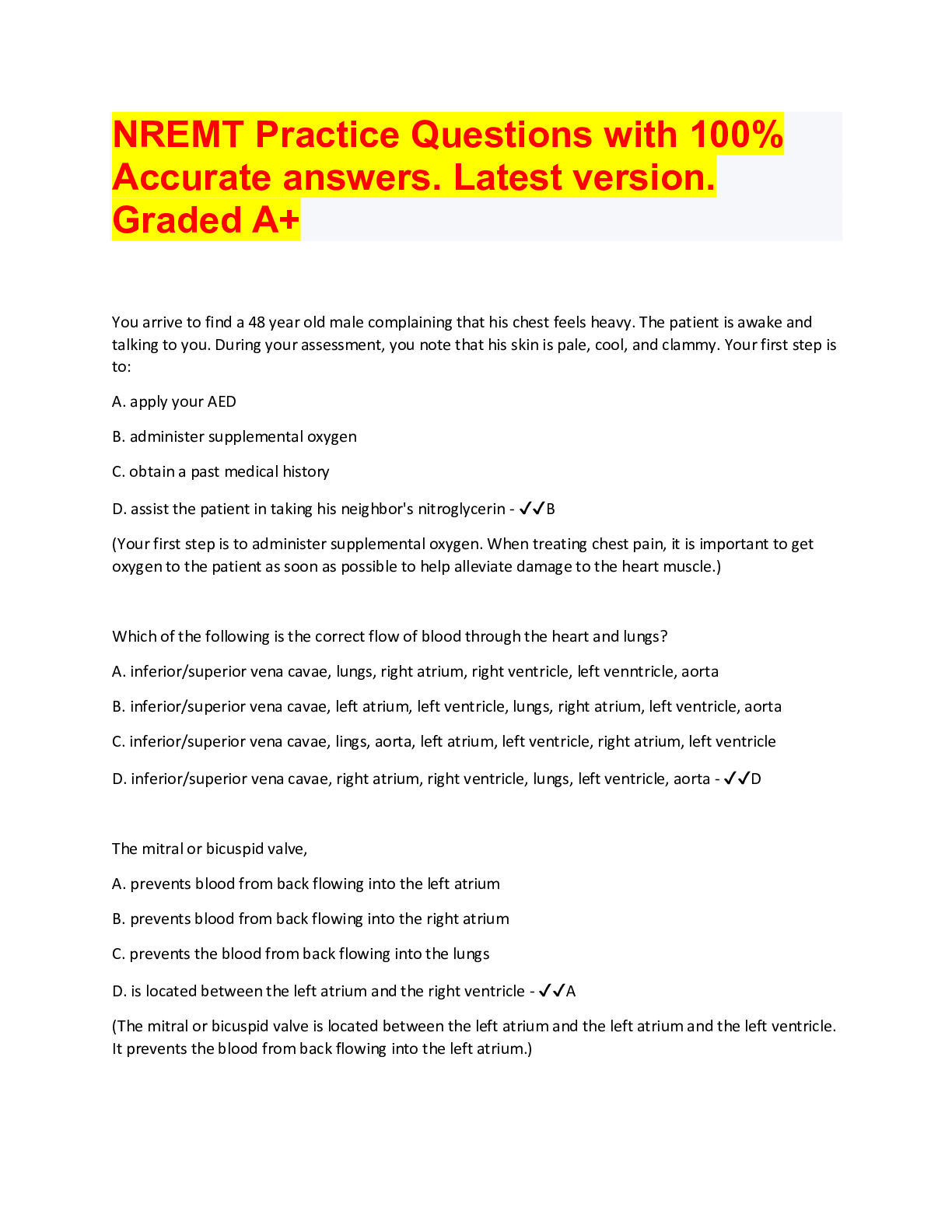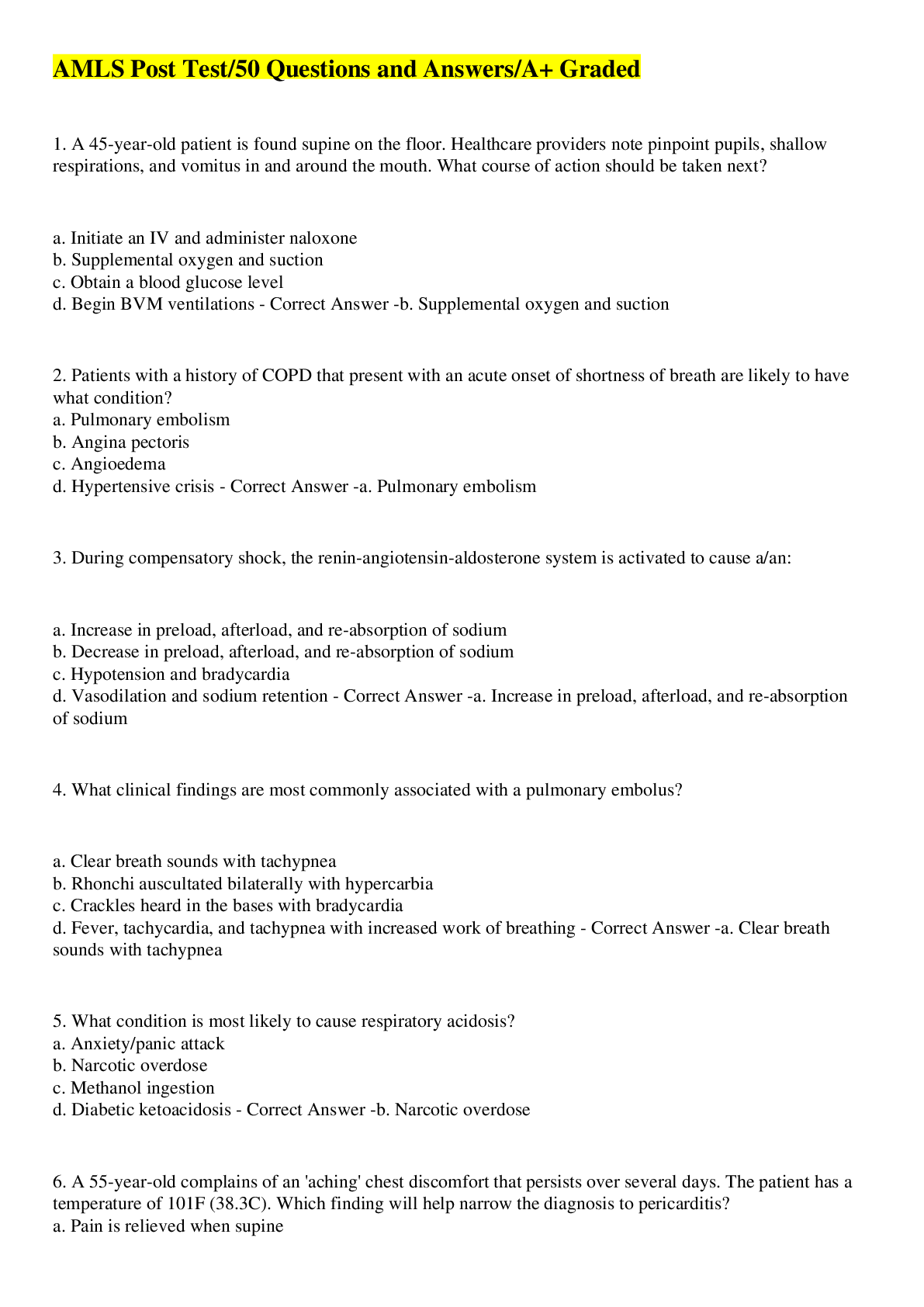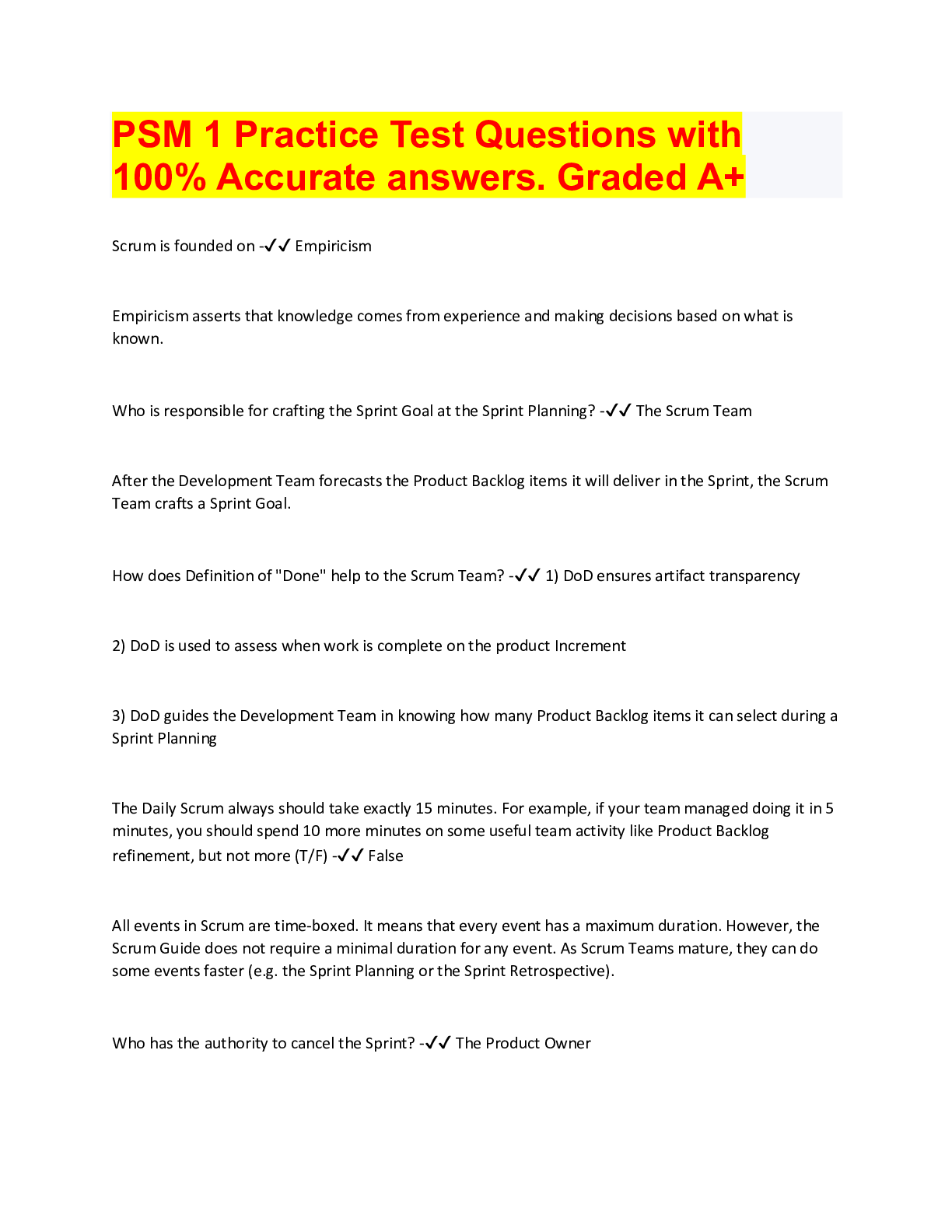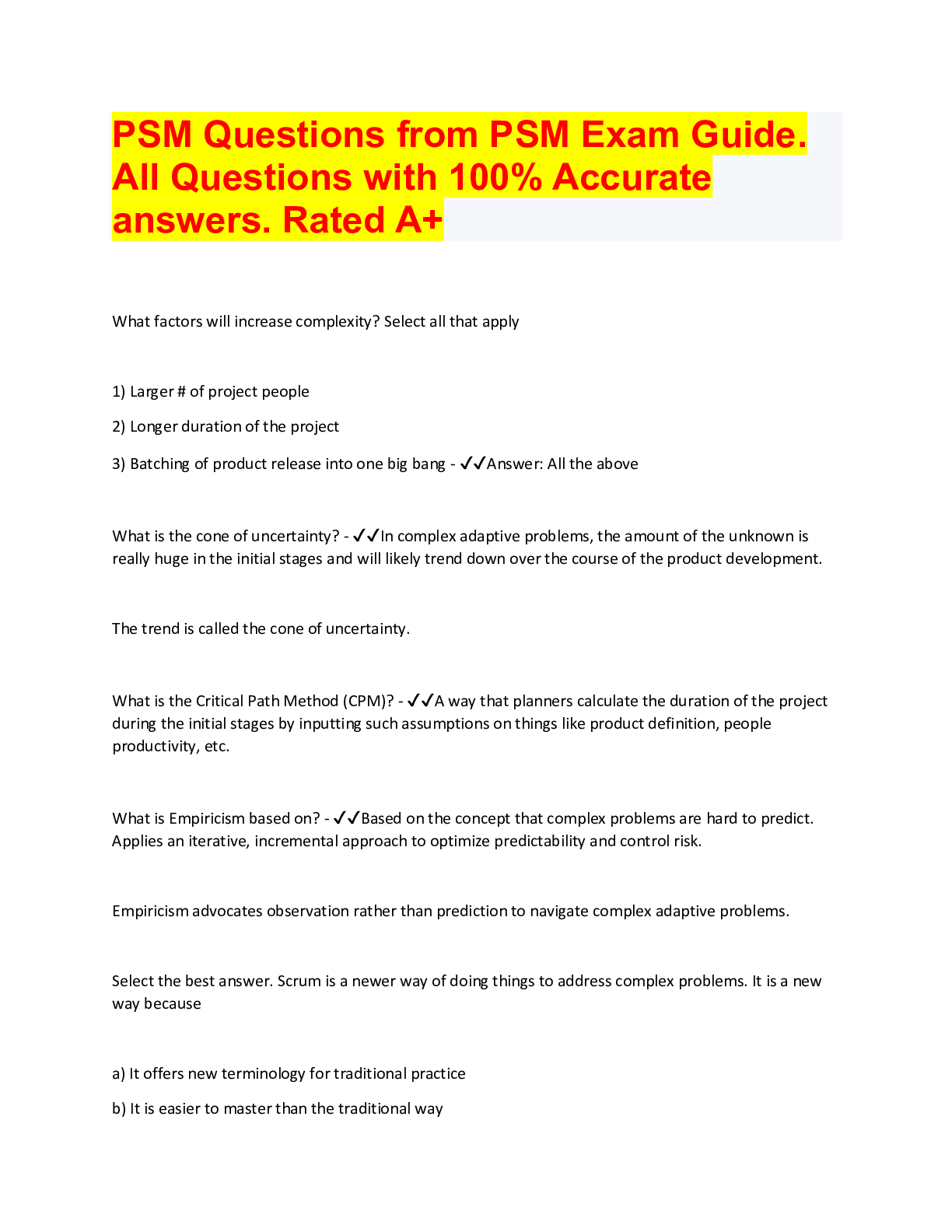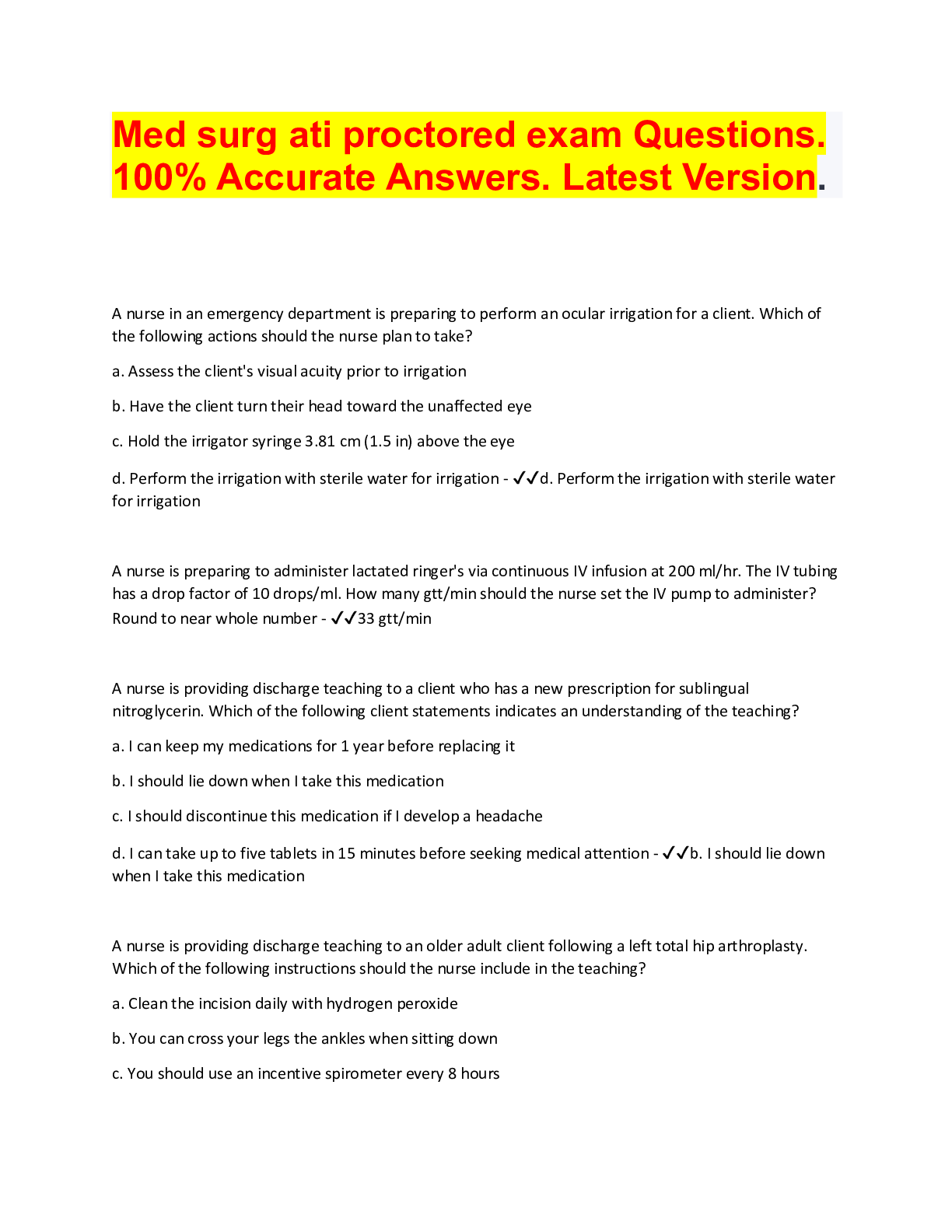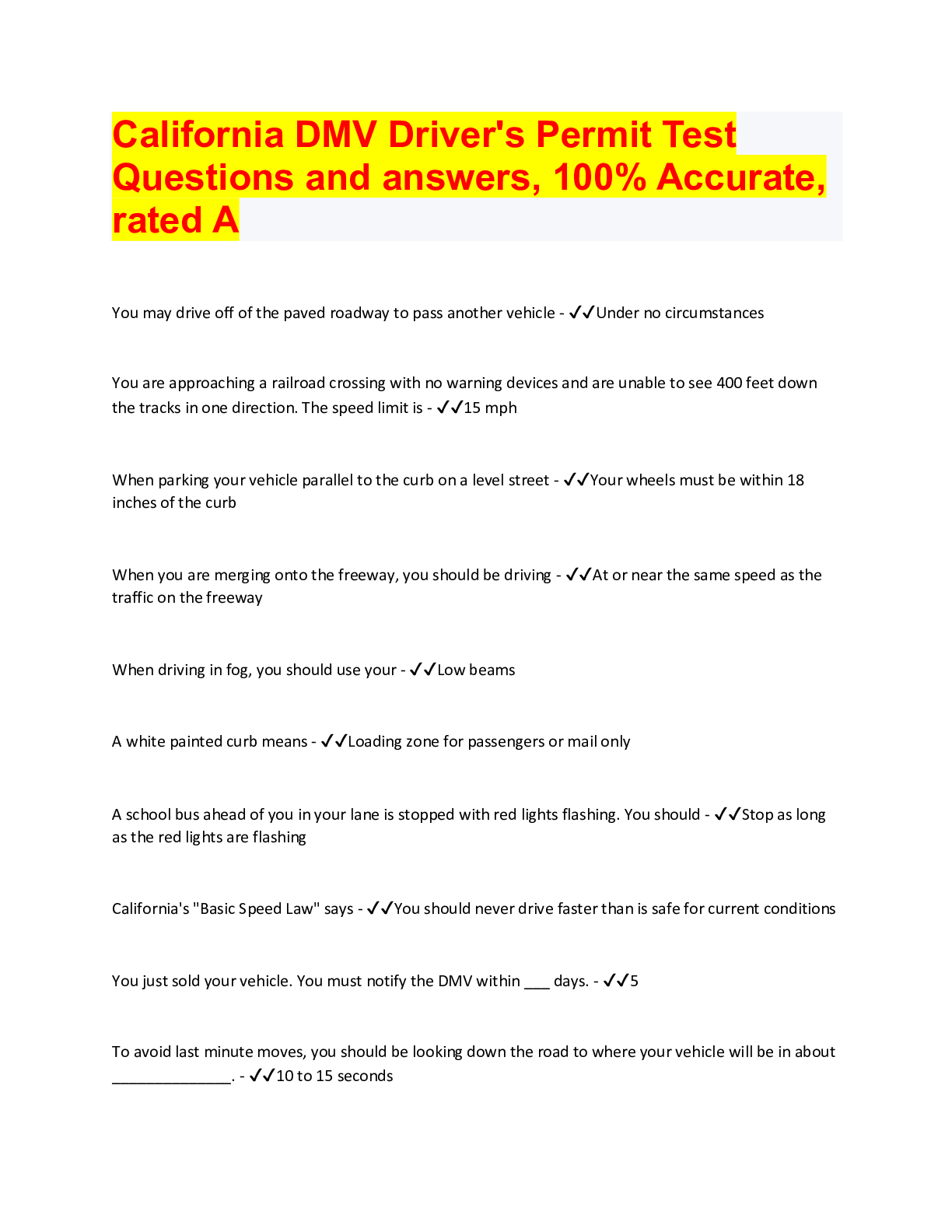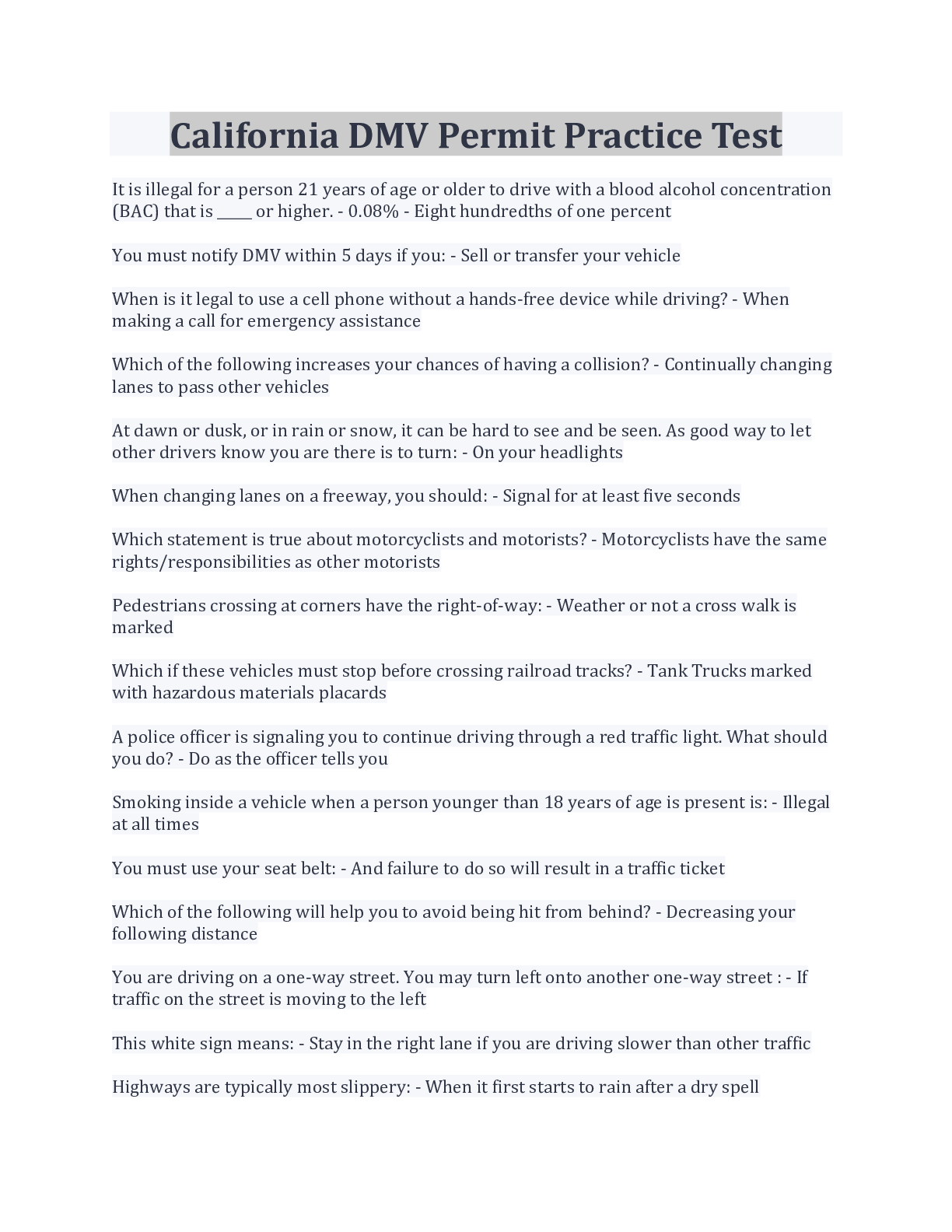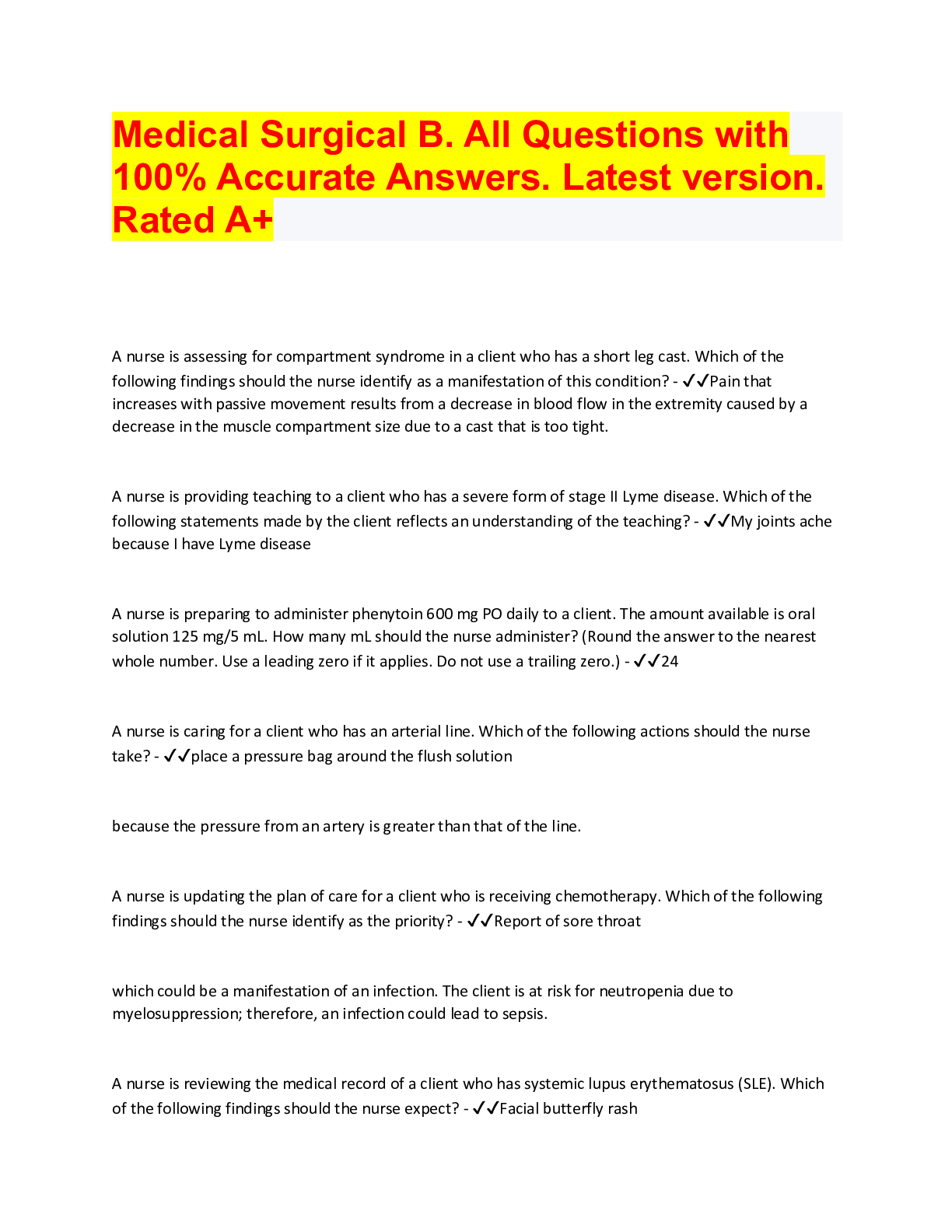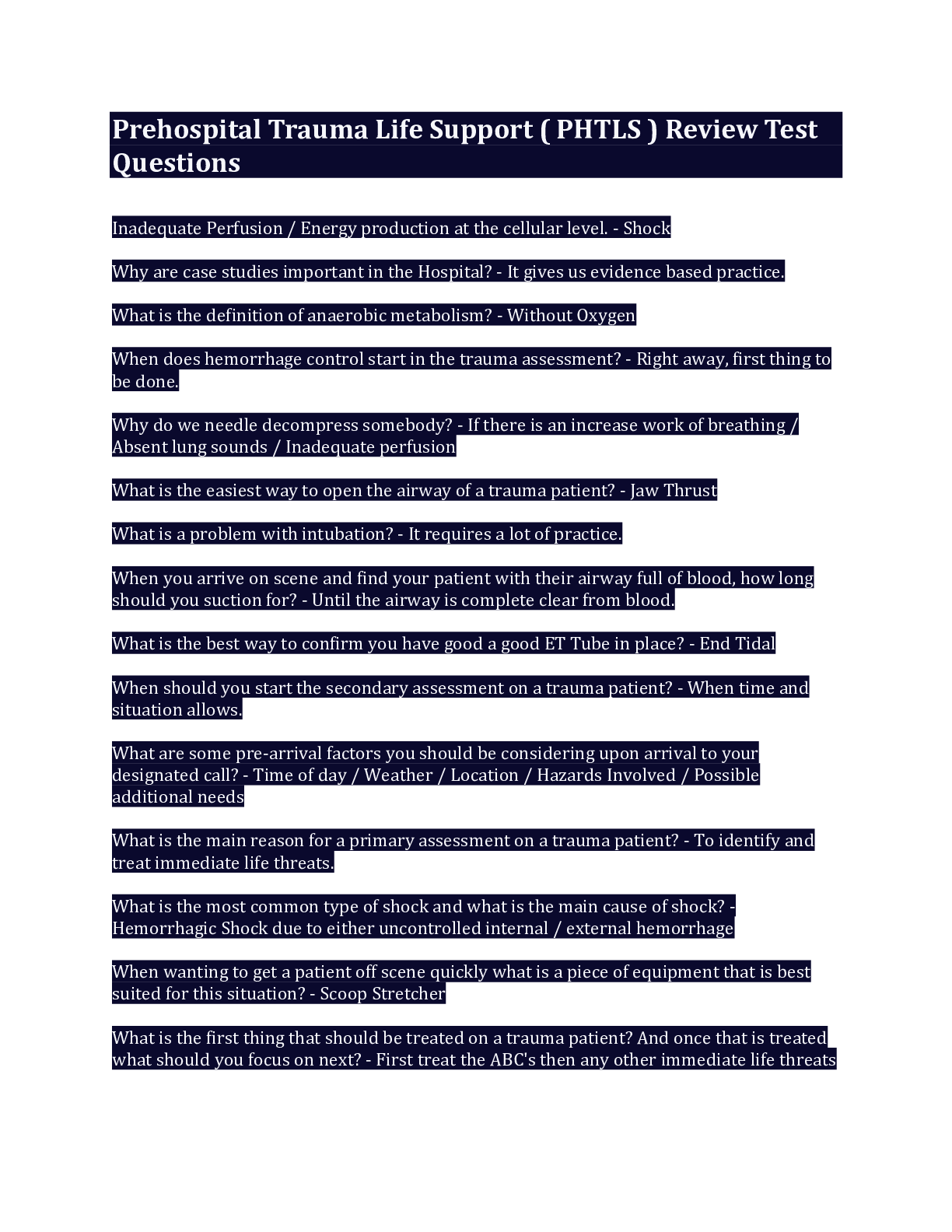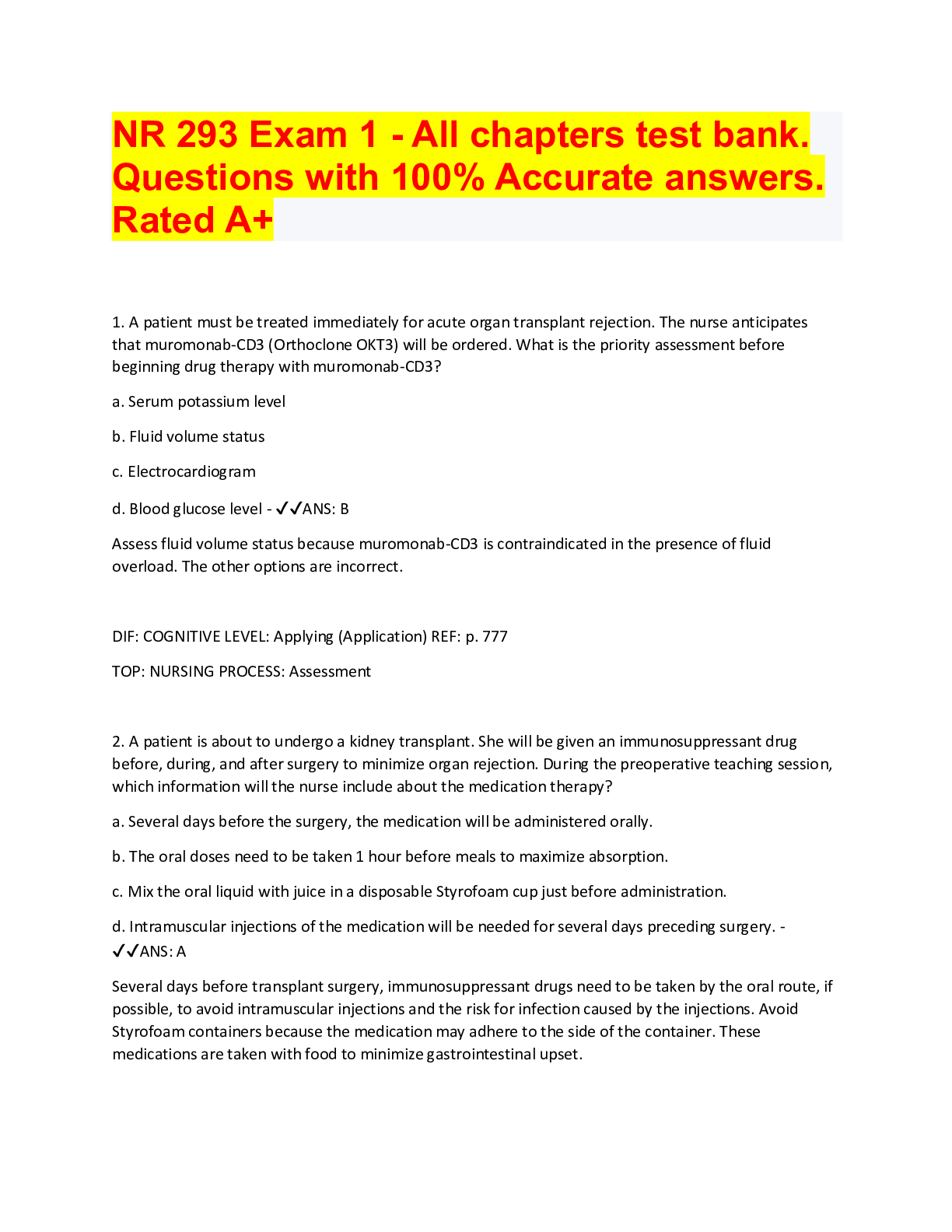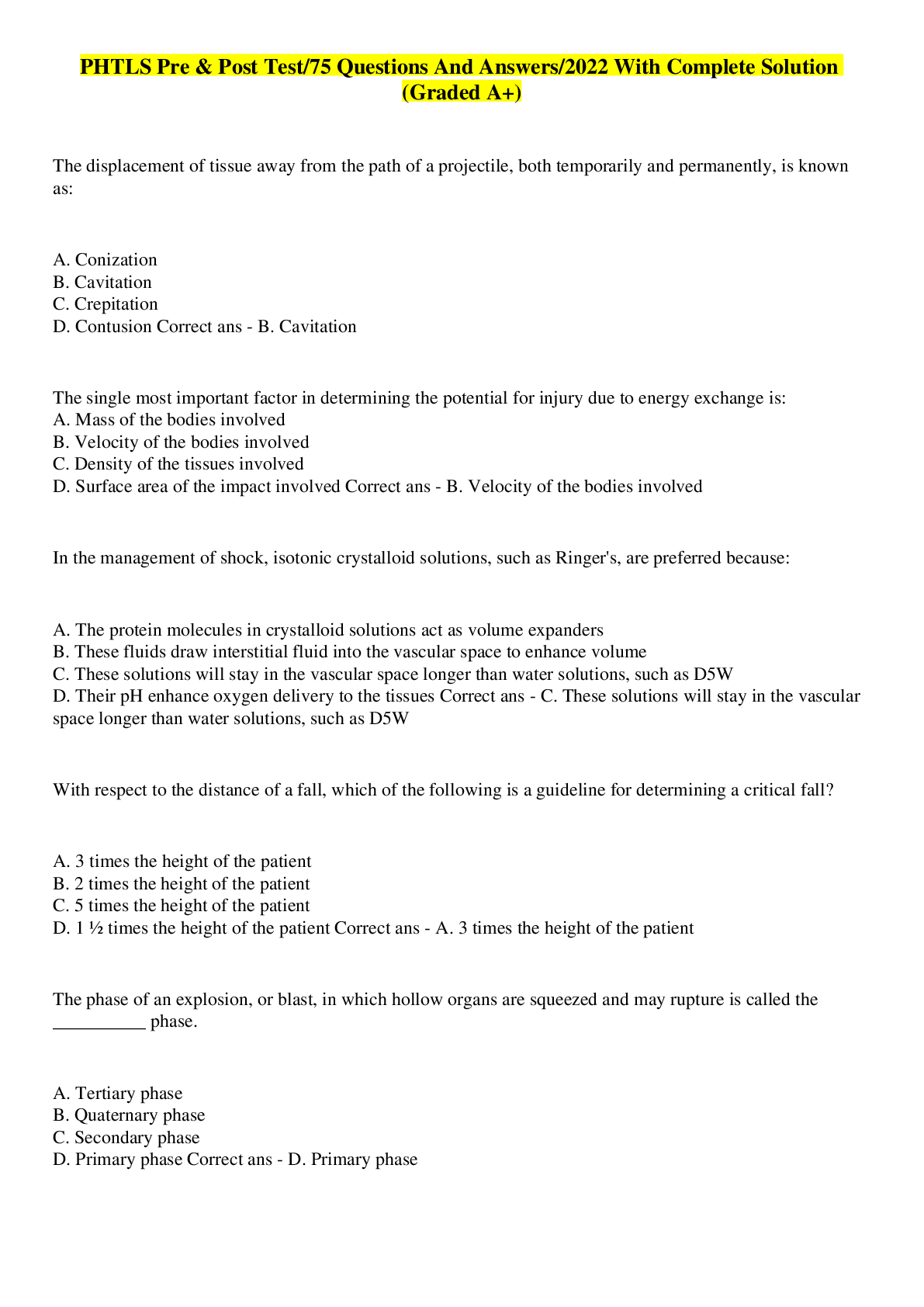*NURSING > QUESTIONS & ANSWERS > NASM CPT Final Exam 2021/2022. All Questions with 100% Accurate answers. Graded A+ (All)
NASM CPT Final Exam 2021/2022. All Questions with 100% Accurate answers. Graded A+
Document Content and Description Below
When is the best time for clients to measure their resting heart rate? - ✔?upon waking in the morning Name two common tests for assessing cardiorespiratory efficiency. - ✔?YMCA 3-Min Step Test ... & Rockport Walk Test What are three methods of assessing body fat percentage? - ✔?Underwater weighing, bioelectrical impedance, and skin fold measurements What is the BMI range for a person who has a very high risk of disease? - ✔?35.0-39.99 What are the two main calf muscles that are responsible for concentrically accelerating plantar flexion? - ✔?Gastrocnemius and soleus Name the muscle that is responsible for concentrically accelerating hip extension and external rotation. - ✔?Gluteus maximus What do you call measurable data regarding a clients physical state, such as body composition, movement assessments, and cardiorespiratory ability? - ✔?Objective information What do you call information gathered from a client that includes their occupation, lifestyle, and medical background - ✔?Subjective information What positional guidelines do you give a client who is setting up for an Overhead Squat assessment? - ✔?Feet shoulder-width apart and pointed straight ahead; foot and ankle complex in a neutral position; arms raised overhead, with elbows fully extended What is the level that a client is instructed to squat to when performing the Overhead Squat assessment? - ✔?Height of a chair Compensations observed during the Overhead Squat assessment from the anterior view. - ✔?Feet turn out and knees move inward Compensations observed during the Overhead Squat assessment from the lateral view. - ✔?Low back arches, excessive forward lean, arms fall forward During an Overhead Squat assessment, what are the probable overactive muscles when the feet turn out? - ✔?Soleus, lateral gastrocnemius, and biceps femoris (short head) During an Overhead Squat assessment, what are the probable underactive muscles if a client's feet turn out? - ✔?Medial gastrocnemius, medial hamstring complex, gracilis, sartorius, popliteus During an Overhead Squat assessment, what are the probable overactive muscles when the knees move inward? - ✔?Adductor complex, biceps femoris (short head), tensor fascia latae, vastus lateralis What are the probable underactive muscles when a client's knees move inward during an Overhead Squat Assessment? - ✔?Gluteus medius/maximus, vastus medialis oblique During an Overhead Squat assessment, what are the probable overactive muscles when there is an excessive forward lean? - ✔?Soleus, gastrocnemius, hip flexor complex, abdominal complex During an Overhead Squat assessment, what are the probable underactive muscles when a client shows an excessive forward lean? - ✔?Anterior tibialis, gluteus maximus, erector spinae During an Overhead Squat assessment, what are the probable overactive muscles when the low back arches? - ✔?Hip flexor complex, erector spinae, latissimus dorsi During an Overhead Squat assessment, what are the probable underactive muscles when a client's low back arches? - ✔?Gluteus maximus, hamstring complex, intrinsic core stabilizers During an Overhead Squat assessment, what are the probable overactive muscles when the client's arms fall forward? - ✔?Latissimus dorsi, teres major, pectoralis major/minor What are the probable underactive muscles when a client's arms fall forward during an Overhead Squat Assessment? - ✔?Middle/lower trapezius, rhomboids, rotator cuff After assessing a client's Overhead Squat, which muscles should you have them foam roll and stretch? - ✔?Overactive muscles After assessing a client's Overhead Squat, which muscles should you have them strengthen? - ✔?Underactive muscles Name movement compensations observed during a Pushing assessment. - ✔?Low back arches, shoulder elevates, head migrates forward During a Pushing assessment, what are the probable overactive muscles when a client's lower back arches? - ✔?Hip flexors and erector spinae During a Pushing assessment, what are the probable underactive muscles when a client's lower back arches? - ✔?Intrinsic core stabilizers During a Pushing assessment, what are the probable overactive muscles when a client's shoulder elevates/head migrates forward? - ✔?Upper trapezius, sternocleidomastoid, and levator scapulae During a Pushing assessment, what are the probable underactive muscles when a client's shoulders elevate? - ✔?Middle/ lower trapezius During a Pushing assessment, what are the probable underactive muscles when a client's head protrudes forward? - ✔?Deep cervical flexors Name the assessment that measures lower extremity agility and neuromuscular control. - ✔?Shark Skill Test What is an indicator that a female client's ankle complex will be in a plantar flexed position for extended periods of time based on occupation? - ✔?Wearing dress shoes (high heels) Name the class of medication that decreases heart rate and blood pressure - ✔?Beta-blockers Name 2 conditions in which Beta-blockers might be prescribed. - ✔?High blood pressure and arrhythmias What muscle action develops tension while lengthening and prevents resistance from accelerating in an uncontrolled manner? - ✔?Eccentric What muscle action develops when a muscle exerts more force than is placed on it, resulting in the shortening of the muscle? - ✔?Concentric Name the imaginary bisector that divides the body into right and left halves. - ✔?Sagittal plane This movement primarily occurs from side to side, as if there were a wall in front of and behind the body. - ✔?Frontal plane movements Name the energy storage and transfer unit within the cells of the body. - ✔?Adenosine Triphosphate or ATP What is the starting zone of cardiorespiratory training when a client scores poor during the YMCA 3-Minute Step Test? - ✔?Zone one What is the starting zone of cardiorespiratory training when a client scores average on the YMCA 3-Minute Step Test? - ✔?Zone two What information can be provided to the health and fitness professional by knowing the client's occupation? - ✔?Common movement patterns What relevant information can you learn about a client based on their occupation and movement capacity? - ✔?Extended periods of sitting, repetitive movements, dress shoes, mental stress Which muscles have decreased neural control once a client has had an ankle sprain? - ✔?Gluteus maximus and gluteus medius This chamber of the heart gathers oxygenated blood coming to the heart from the lungs. - ✔?Left atrium Give the straight percentage method equation for calculating a client's target heart rate. - ✔?(220-client's age) x desired intensity Name the muscles involved in respiratory inspiration. - ✔?Name the muscles involved in respiratory inspiration. Diaphragm, external intercostals, scalenes, sternocleidomastoid, pectoralis minor What are three guidelines for the health and fitness professional when taking the radial pulse of a client? - ✔?Touch should be gentle, take the pulse when the client is calm, take the pulse over the course of 3 days (at the same time each day) and average the results to ensure accuracy Name the functional unit of the muscle that lies in the space between two Z lines. It produces muscular contraction and is formed by repeating sections of actin and myosin. - ✔?Sarcomere The science concerned with the internal and external forces acting on the human body and the effects produced by these forces. - ✔?Biomechanics The heart rate training zone between 65 to 75% that builds an aerobic base and aids in recovery. - ✔?Zone 1 The heart rate training zone between 76 to 85% that increases both aerobic and anaerobic endurance. - ✔?Zone 2 The heart rate training zone between 86 to 95% that builds high-end work capacity. - ✔?Zone 3 Represents the pressure within the arterial system after the heart contracts. - ✔?Systolic blood pressure Represents the pressure within the arterial system when the heart is resting and filling with blood. - ✔?Diastolic blood pressure The method of measuring body fat percentages that conducts an electrical current through the body to measure fat. - ✔?Bioelectrical impedance What are the four skin-fold sites tested when using the Durnin-Womersley formula for body fat assessment? - ✔?Biceps, triceps, subscapular, iliac crest What is the waist-to-hip ratio for males and females that puts them at a greater risk for disease? - ✔?A ratio greater than 0.95 for males and greater than 0.80 for females Muscles that assist the prime movers. - ✔?Synergists Risk for disease increases when an overweight person's BMI level is____. - ✔?25 or greater Sensory receptors responsible for sensing distortion in body tissues. - ✔?Mechanoreceptors What is the amount of time recovery pulse is taken after completing the YMCA 3- Minute Step Test? - ✔?Within 5 seconds of completing the exercise, take the client's pulse for 60 seconds Receptors sensitive to change in tension of the muscle and the rate of that change. - ✔?Golgi tendon organs Receptors sensitive to change in length of the muscle and the rate of that change - ✔?Muscle Spindles On which clients should health and fitness professionals avoid the use of skin-fold calipers to measure body fat? - ✔?Very overweight clients The resting length of a muscle and the tension the muscle can produce at this resting length. - ✔?Length-tension relationship What is the functional unit of the nervous system? - ✔?Neuron The neuromuscular phenomenon that occurs when inappropriate muscles take over the function of a weak or inhibited prime mover. - ✔?Synergistic dominance The process in which neural impulses that sense tension are greater than the impulses that cause muscles to contract, providing an inhibitory effect to the muscle spindles. - ✔?Autogenic inhibition Name some of the benefits of circumference measurements. - ✔?Can be used on obese clients, good for comparisons and progressions, good for assessing fat patterns and distribution, inexpensive, easy to record Name the systems of the human movement system (kinetic chain). - ✔?Nervous system, muscular system, skeletal system Name the agonist, synergist, stabilizer, and antagonist muscles activated during a squat exercise. - ✔?Agonists: Gluteus maximus, quadriceps; Synergists: Hamstring complex; Stabilizer: Transversus abdominis; Antagonist: Psoas What are some primary causes of muscle imbalance? - ✔?Postural stress, emotional duress, repetitive movement, cumulative [Show More]
Last updated: 1 year ago
Preview 1 out of 48 pages
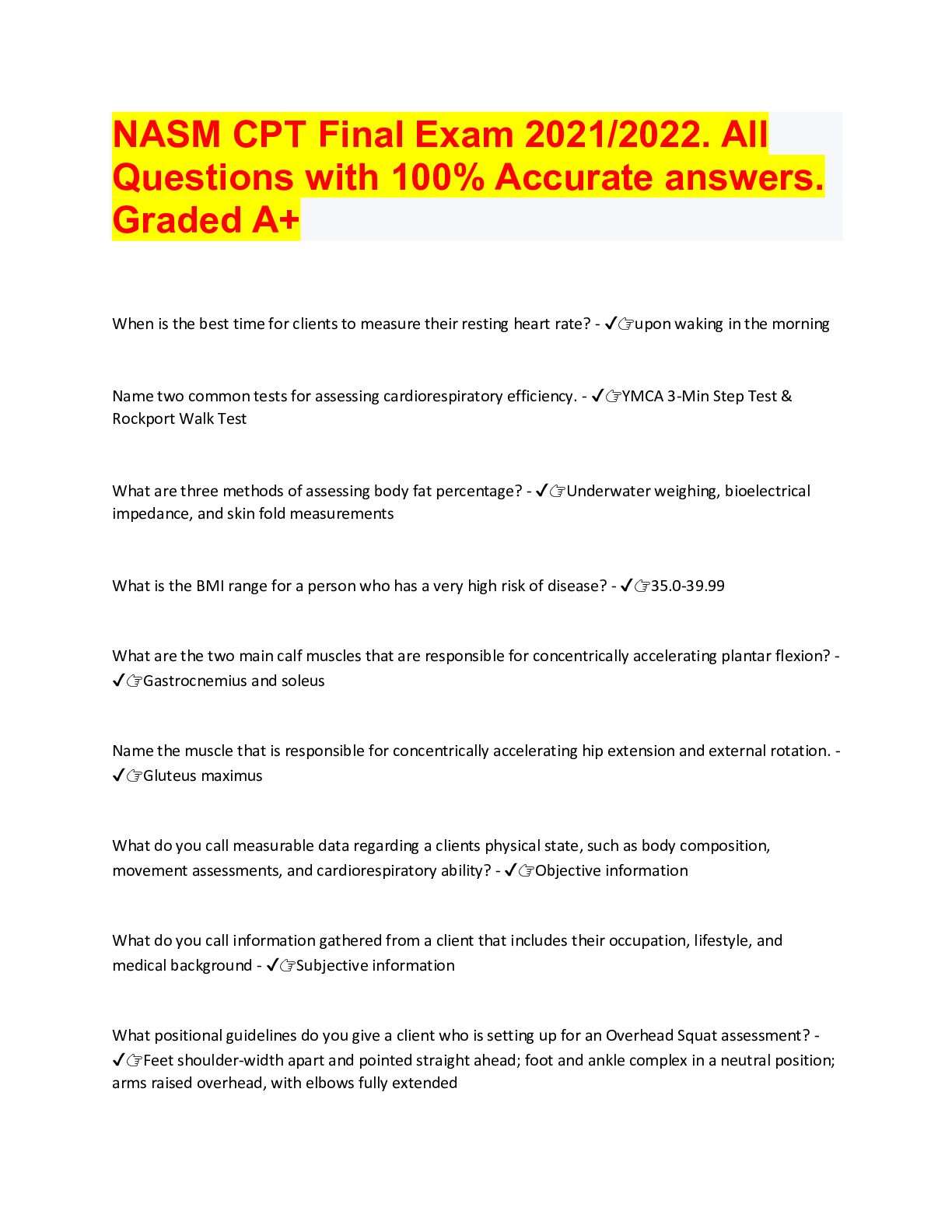
Also available in bundle (1)

NASM CPT BUNDLE, Questions and answers,.
All Questions and answers, Predictor questions. Graded A+
By bundleHub Solution guider 1 year ago
$38
14
Reviews( 0 )
Document information
Connected school, study & course
About the document
Uploaded On
Aug 12, 2022
Number of pages
48
Written in
Additional information
This document has been written for:
Uploaded
Aug 12, 2022
Downloads
0
Views
127



